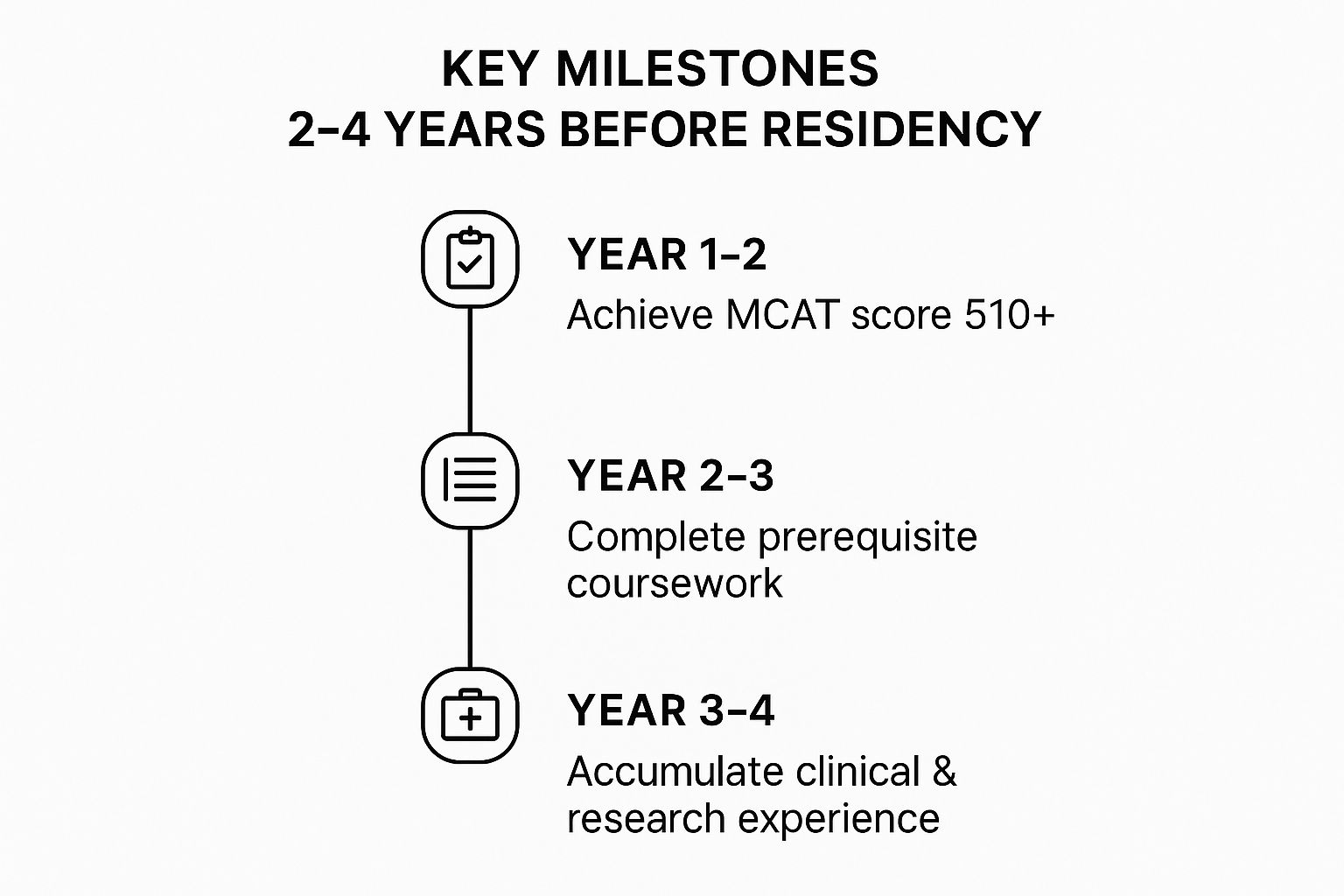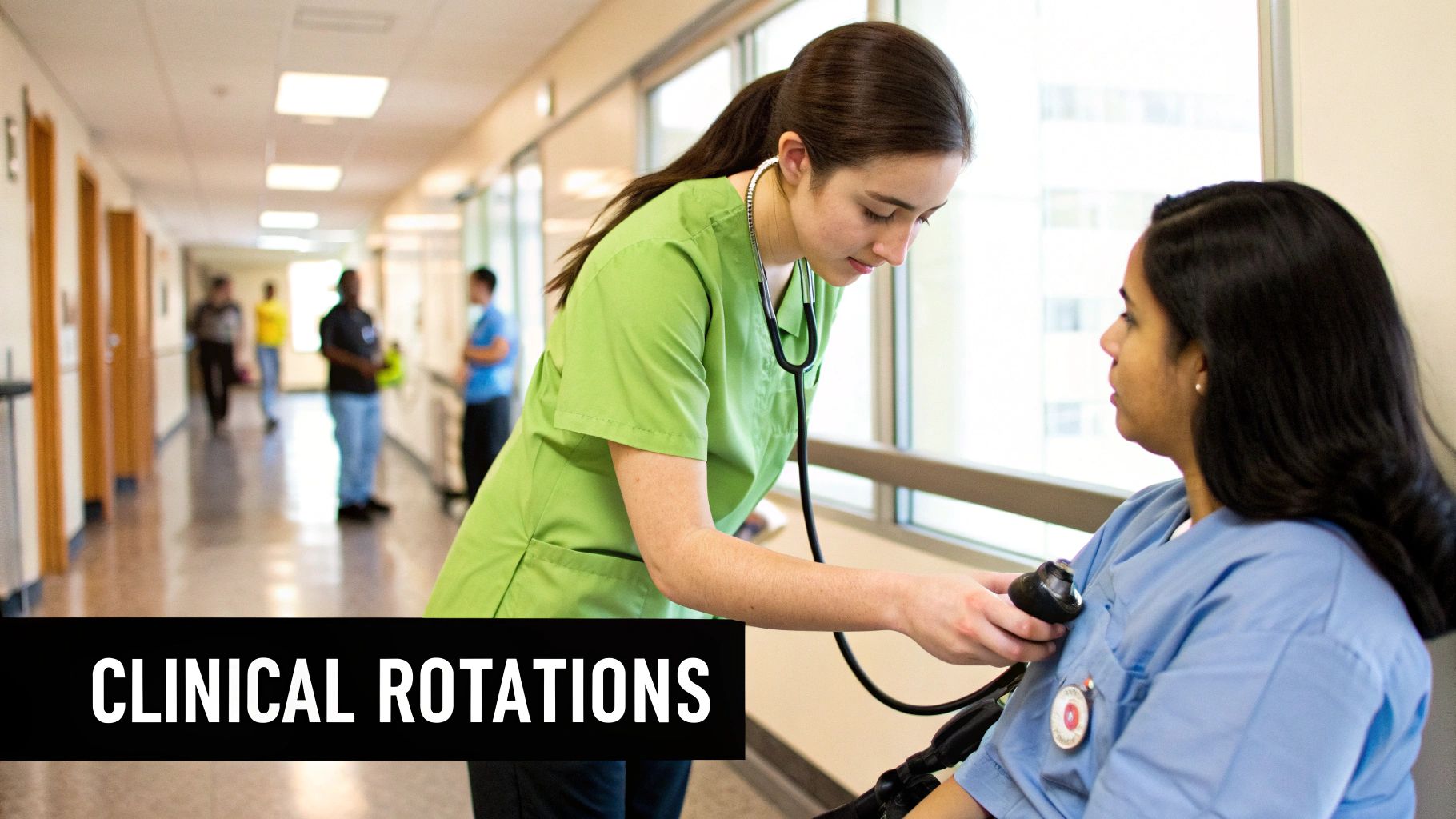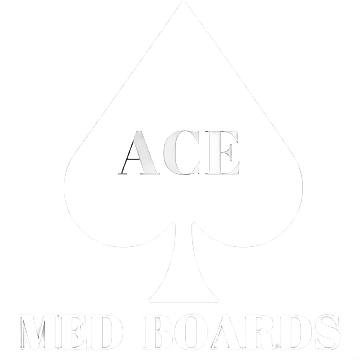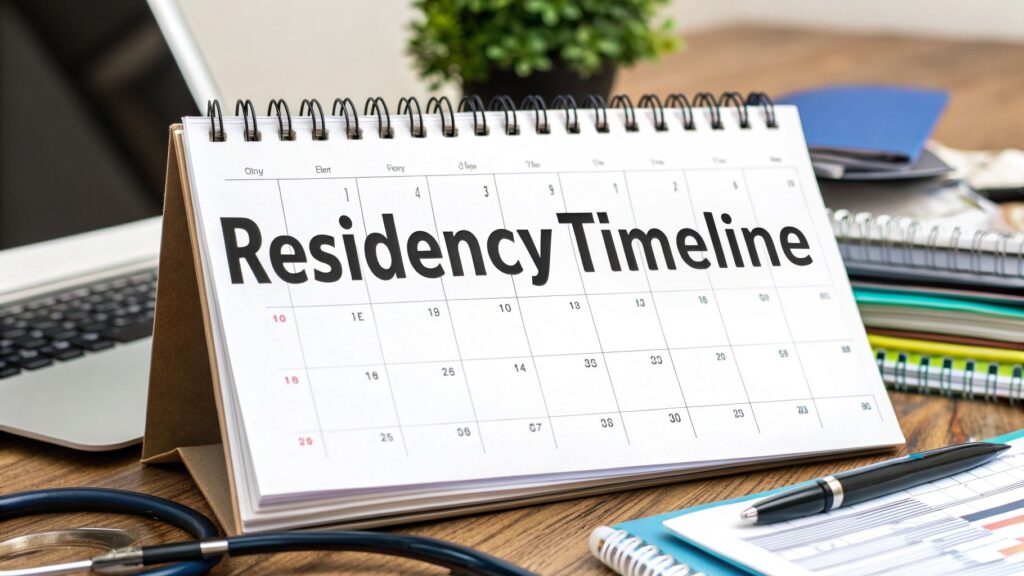Navigating the journey from medical student to resident physician is a multi-year marathon, not a sprint. A successful match hinges on strategic planning, timely execution, and a deep understanding of each critical phase. While many applicants know the major deadlines, the most competitive candidates master the nuances of the residency application timeline, turning potential stressors into strategic advantages. They understand that what they do years before the Electronic Residency Application Service (ERAS) opens is just as crucial as the interview season itself. This guide moves beyond the basic checklist to provide a detailed, phase-by-phase roadmap for your entire journey.
This comprehensive listicle breaks down the process into eight distinct, manageable stages. We will cover everything from foundational planning during your preclinical years to the final steps after Match Day. You will learn not just what to do, but how and when to do it for maximum impact. We'll provide actionable insights, specific examples, and expert strategies designed for a diverse range of applicants, including U.S. medical students, osteopathic candidates, International Medical Graduates (IMGs), and those re-applying to the match.
Key Takeaway: A well-managed timeline is your single greatest tool for building a competitive residency application without succumbing to burnout. It allows you to transform a complex, overwhelming process into a series of achievable milestones.
Our goal is to equip you with a personalized framework for success. By strategically planning your research, clinical rotations, board exams, and personal statement development, you can build a standout application, excel in your interviews, and confidently step into your chosen residency program. Let’s get started on mapping your path.
1. MCAT Preparation and Medical School Planning (2-4 years before residency)
The foundation for a successful residency match is built years before you even begin medical school. Your journey on the residency application timeline truly starts with your performance as a pre-medical student. This initial phase, occurring 2 to 4 years before residency even begins, is about creating a strong academic and experiential profile to gain admission to a medical school that aligns with your long-term career aspirations.
Laying the Groundwork for Success
This stage involves a multi-pronged approach focused on demonstrating academic readiness and a genuine commitment to medicine. It's not just about checking boxes; it's about strategically building a compelling narrative that will carry you through medical school admissions and beyond.
- MCAT Excellence: Your MCAT score is a critical data point. Aiming for a score that is competitive for your target schools is paramount. Comprehensive preparation programs, like those offered by Kaplan or Princeton Review, provide structured study plans and practice materials. The key is to take the exam only when you are thoroughly prepared, rather than rushing to meet a self-imposed deadline.
- Strategic Experience: Gaining relevant experience is crucial. This can include clinical volunteering, shadowing physicians, or engaging in research. For example, some students use a gap year to work as a research assistant at the NIH or an academic medical center, gaining invaluable skills and professional connections.
- Early Mentorship: Building relationships with professors and physicians early on is vital. These individuals can provide guidance, write strong letters of recommendation for your medical school application, and potentially serve as mentors throughout your medical career.
Key Insight: Treat every pre-medical experience as a potential building block for your residency application. Keep detailed records of your roles, responsibilities, and reflections. This habit will make assembling your ERAS application significantly easier down the line.
The following timeline highlights the crucial milestones during your undergraduate years that set the stage for medical school and, ultimately, residency.

This visual underscores how foundational academic achievements in the early years pave the way for essential hands-on experience later in your pre-medical journey.
2. Medical School Years 1-2: Building Academic Foundation
Once you've secured your place in medical school, the residency application timeline transitions to a new, critical phase: the preclinical years. This period, typically the first one to two years of your medical education, is dedicated to building a robust scientific and clinical knowledge base. Your performance here sets the stage for success on board exams and in your future clinical rotations.
Laying the Groundwork for Success
The preclinical years are more than just classroom learning; they are your first opportunity to actively shape your future career path within medicine. This involves a strategic balance of academic diligence, early specialty exploration, and professional networking. To excel in these foundational years and prepare for rigorous exams, explore proven effective study methods for medical students to build strong academic habits.
- Coursework and Board Exam Prep: Your primary focus is excelling in your coursework, as this knowledge forms the bedrock for the USMLE Step 1 exam. Many students find success using spaced repetition systems like Anki, creating detailed flashcards to master the vast amount of information. Success on Step 1 is a significant data point for residency programs.
- Early Specialty Exploration: Begin exploring potential specialties through interest groups and shadowing opportunities. These activities demonstrate proactive engagement and help you make an informed decision later. For example, joining a surgery interest group might provide access to workshops and networking events with surgical residents and attendings.
- Productive Summers: Use the summer break between first and second year strategically. This is an ideal time for a dedicated research experience, such as participating in a structured summer research program at an institution like Mayo Clinic or Johns Hopkins. These experiences can lead to publications and strong letters of recommendation.
Key Insight: Maintain a detailed log of every activity, from shadowing a physician to your role in a research project. Document dates, responsibilities, key learnings, and contact information for supervisors. This "living CV" will become an invaluable resource when you begin compiling your ERAS application.
3. Medical School Year 3: Clinical Rotations and Specialty Exploration
The third year of medical school marks a pivotal transition from classroom theory to practical application in the clinical setting. This phase of the residency application timeline is defined by core clinical rotations where you gain firsthand experience across major specialties like internal medicine, surgery, pediatrics, and psychiatry. It is during these immersive experiences that you will truly begin to identify your career path and build the clinical foundation for your residency application.

Laying the Groundwork for Success
Success in your third year requires a dual focus: excelling in your current rotation while simultaneously preparing for the next major hurdles, including the USMLE Step 2 CK exam and solidifying your specialty choice. This year is less about passive learning and more about active engagement, professional development, and strategic planning.
- Clinical Excellence and Networking: Treat every rotation as a potential audition for your future career, even if it's not in your specialty of interest. Actively seek feedback, demonstrate a strong work ethic, and build positive relationships with residents and attending physicians. For instance, an outstanding performance on your surgery rotation can lead to a powerful letter of recommendation, even if you ultimately apply for family medicine.
- Targeted Exam Preparation: The USMLE Step 2 CK assesses your clinical knowledge. Parallel to your rotations, you should be using resources like UWorld question banks to study for the associated shelf exams. This continuous preparation builds a strong foundation, making your dedicated Step 2 study period more of a review than a cram session.
- Strategic Exploration: Use each rotation to critically evaluate whether a specialty fits your personality, skills, and long-term goals. If a rotation sparks your interest, seek opportunities to engage further, perhaps by participating in a small research project or finding a mentor within that department.
Key Insight: Document your significant patient encounters, procedures you performed, and interesting clinical cases in a journal or digital log. These detailed notes are invaluable when writing your personal statement and filling out the experiences section of your ERAS application, providing concrete examples of your growth and commitment.
This period demands exceptional organization. For practical advice on juggling clinical duties, shelf exams, and Step 2 prep, you can explore effective medical student time management tips.
4. Medical School Year 4 (Spring): Research, Away Rotations, and Application Preparation
The spring semester of your fourth year marks the final, high-stakes preparatory phase in the residency application timeline. This period is a critical sprint to solidify your competitiveness, finalize your specialty choice, and assemble the core components of your application. It’s where you transition from a student into a prospective resident, showcasing your clinical skills and research acumen on a national stage.
Finalizing Your Candidate Profile
This stage is about strategically polishing your application and making lasting impressions. It involves a concentrated effort to complete key experiences, secure powerful endorsements, and begin crafting the narrative that will define you to program directors. Success during this phase hinges on meticulous planning and proactive engagement.
- Strategic Away Rotations: For competitive specialties, away rotations (or "audition" rotations) are non-negotiable. These are your opportunities to impress faculty at your top-choice programs. For instance, a student aiming for orthopedic surgery might secure a rotation at the Mayo Clinic or Hospital for Special Surgery to gain exposure and a potential letter of recommendation from leaders in the field. Applying early through the Visiting Student Application Service (VSAS/VSLO) is essential as spots fill up quickly.
- Research Completion and Publication: Bring your research projects to a conclusion. The goal is to have tangible outcomes, such as a submitted manuscript, a published abstract, or a presentation at a national conference. Getting your name on a publication in a specialty-specific journal before the application deadline significantly strengthens your profile.
- Securing Letters of Recommendation (LoRs): Finalize your list of letter writers. By now, you should have identified faculty members who know you well from clinical rotations, research, or mentorship. Approach them professionally, providing your CV, personal statement draft, and a clear deadline. Maintaining these professional relationships is paramount to receiving a strong, personalized letter.
Key Insight: Treat your personal statement as a living document during this period. Seek feedback from multiple trusted sources, including your specialty advisor, a writing center, and residents in your chosen field. Many medical schools offer personal statement workshops; attending these can provide invaluable structural and content-related guidance.
The activities you complete during the spring of your fourth year are not just about checking boxes; they are the final, powerful data points that will populate your ERAS application and directly influence your interview invitations.
5. ERAS Application Submission (September)
September marks the official launch of the residency application season. The Electronic Residency Application Service (ERAS) allows you to begin submitting your meticulously prepared application to your chosen residency programs. This moment is the culmination of years of hard work, transforming your academic achievements, clinical experiences, and personal narrative into a comprehensive package for program directors to review.
Going Live with Your Application
This phase is about a final, thorough review and strategic submission. After months of drafting and polishing, your application is ready to be sent, but careful execution is critical to avoid unforced errors. It’s a high-stakes step in the residency application timeline where precision and timing can make a significant difference.
- Strategic Submission: Aim to submit your application on the first day ERAS opens for programs to review, or as close to it as possible. Programs often begin reviewing applications immediately, and an early submission demonstrates your enthusiasm and preparedness. There is no advantage to waiting.
- Broad and Targeted Application: The number of programs you apply to depends on your specialty and competitiveness. A student applying to a less competitive internal medicine track might target 20-30 programs, whereas an applicant for a highly competitive specialty like dermatology or orthopedic surgery may need to apply to 50 or more programs to maximize their chances.
- Final Verification: Before you click "submit," perform one last, exhaustive review of every section. Check for typos, grammatical errors, and inconsistencies. Ensure your letters of recommendation have been uploaded and that your USMLE/COMLEX transcript is assigned correctly. You can get a better sense of the final product by reviewing a sample ERAS application to compare against your own.
Key Insight: Treat the submission process like a final pre-flight check. Create a checklist of every document and piece of information, and physically tick each item off as you confirm its accuracy in the ERAS portal. Once you certify and submit, most sections cannot be changed.
6. Interview Season (October-February)
The period from October to February marks the most dynamic and crucial phase of the residency application timeline: interview season. After submitting your ERAS application, this is when programs review your materials and extend invitations to the candidates they are most interested in. This intensive stretch requires sharp organizational skills, strategic preparation, and the ability to present your best self while evaluating programs for fit.
Navigating the Interview Gauntlet
This stage is a two-way street. While you are being evaluated, you are also assessing whether a program aligns with your educational needs, career goals, and personal well-being. Successfully managing this period is key to a favorable match outcome.
- Responding and Scheduling: Interview invitations can arrive at any time, often with limited slots available. It is critical to monitor your email constantly and respond immediately. Students often use scheduling tools or dedicated spreadsheets to manage their calendars and avoid double-booking. Platforms like Interview Broker or Thalamus are commonly used by programs to streamline this process.
- Virtual and In-Person Formats: While virtual interviews became the standard during the pandemic, programs may use a hybrid model. For virtual interviews, ensure you have a professional background, reliable technology, and good lighting. Programs often supplement virtual interviews with optional in-person second looks or virtual social events to give you a feel for their culture.
- Thorough Preparation: Research each program extensively before your interview day. Understand its mission, faculty research interests, and unique curricular tracks. Prepare thoughtful answers to common questions and formulate specific questions of your own that demonstrate genuine interest. Keeping detailed notes in a journal or spreadsheet for each program is essential for making informed decisions when creating your rank order list.
Key Insight: Treat every interaction as part of the interview, from emails with the program coordinator to virtual social hours with residents. Professionalism, enthusiasm, and courtesy are constantly being evaluated. After each interview, send a personalized thank-you note or email to the program director and your interviewers to reiterate your interest.
The video below provides valuable tips for standing out during your residency interviews, covering everything from preparation to execution.
Practicing your responses is a fundamental part of this process. For a comprehensive guide, you can learn more about common residency interview questions to ensure you are ready for any scenario.
7. Rank List Creation and Submission (February)
After months of applications and interviews, the residency application timeline culminates in one of the most significant decisions of your medical career: creating and submitting your Rank Order List (ROL). This is the moment you officially tell the National Resident Matching Program (NRMP) which residency programs you prefer, and in what order. This critical step, typically completed by late February, directly determines your potential match outcome.

The NRMP matching algorithm is applicant-proposing, meaning it is designed to place you in the highest-ranked program on your list that also ranked you. Your certified ROL is a binding commitment, so this phase demands careful introspection and strategic thinking to align your true preferences with your match probabilities.
Crafting Your Definitive List
Creating your ROL is a deeply personal process that involves synthesizing every data point, gut feeling, and career goal from your interview season. It's about translating your experiences into a final, decisive order.
- Rank by True Preference: The single most important rule is to rank programs in your genuine order of preference, not by how you think a program ranked you. The algorithm is designed to work in your favor, so trying to "game the system" by ranking a perceived "safer" program higher than your dream program can backfire and lead to a less desirable match.
- Leverage Data Strategically: Use resources like the NRMP’s Charting Outcomes in the Match to understand the statistical profiles of applicants who successfully matched into your specialty. For example, an applicant to a competitive specialty like Dermatology might analyze data on matched candidates' USMLE scores and research publications to realistically assess their standing and decide how many programs to rank.
- Couples Matching Considerations: For couples participating in the Match, the process involves creating pairs of program choices on your ROLs. This requires extensive communication and compromise, as you must decide whether to prioritize matching at the same institution, in the same city, or simply within a reasonable geographic distance.
Key Insight: Do not rank any program you would be unwilling to attend. A certified Rank Order List is a binding contract. If you match at a program, you are obligated to accept the position. It is better to go unmatched than to be locked into a four-year commitment at a program that is a poor fit for you.
This period is the final strategic checkpoint in the residency application timeline. By thoughtfully constructing and certifying your ROL, you position yourself for the best possible outcome on Match Day, taking a definitive step toward your future as a resident physician.
8. Match Day and Residency Preparation (March-June)
The culmination of the entire residency application timeline arrives in March with Match Week. This period is the final, exhilarating, and sometimes nerve-wracking, step that transitions you from a medical student to a resident physician-in-training. It begins with the reveal of whether you matched and culminates in discovering where you will spend the next several years of your medical career.
Navigating the Final Transition
This phase is a whirlwind of emotion, logistics, and preparation. It starts with the intense anticipation of Match Day and immediately pivots to the practicalities of starting your residency program. Successful navigation requires quick, decisive action and careful planning for the months ahead.
- Match Week and SOAP: The third Monday of March, you find out if you matched into a residency program. For those who do not match, the Supplemental Offer and Acceptance Program (SOAP) begins immediately, offering a frantic, four-day process to secure an unfilled position. The week concludes on Match Day, the third Friday of March, when all matched applicants discover where they will be training, often celebrated with ceremonies at medical schools nationwide.
- Post-Match Logistics: Once your match is confirmed, the real work of preparation begins. This is not the time to coast. You must immediately start the onboarding process for your new program, which includes credentialing, background checks, and drug screening. Securing state-specific medical licensure or a training permit is a top priority and can be a lengthy process.
- Personal and Professional Readiness: Beyond the paperwork, you must prepare for a significant life change. This involves finding housing in a new city, planning your move, and managing your finances for the transition period before your first paycheck. It's also a critical time to connect with your new program director, coordinators, and future co-residents.
Key Insight: Do not underestimate the post-match administrative burden. Create a detailed checklist immediately after Match Day, including deadlines for licensure, program paperwork, and housing deposits. Contact your new program coordinator early to understand their specific requirements and timeline.
The period from March to June is your final sprint before the marathon of residency begins. It’s a crucial window to organize your personal and professional life so you can start PGY-1 year on solid ground, ready to learn and contribute from day one.
Residency Application Timeline: 8-Stage Comparison
| Stage | Implementation Complexity 🔄 | Resource Requirements ⚡ | Expected Outcomes 📊 | Ideal Use Cases 💡 | Key Advantages ⭐ |
|---|---|---|---|---|---|
| MCAT Preparation and Medical School Planning | High 🔄🔄🔄 | High ⚡⚡ | Strong foundational application, med school admission 📊📊 | Early career planning, competitive specialty pursuit 💡 | Early retake opportunity, broad portfolio ⭐⭐ |
| Medical School Years 1-2: Academic Foundation | Moderate 🔄🔄 | Moderate ⚡⚡ | Solid academic base, specialty exploration 📊 | Building knowledge and mentorship early 💡 | Access to mentors, research opportunities ⭐⭐ |
| Medical School Year 3: Clinical Rotations | High 🔄🔄🔄 | High ⚡⚡⚡ | Clinical skills, specialty focus, Step 2 CK 📊📊 | Hands-on clinical experience, specialty decision making 💡 | Real-world exposure, network building ⭐⭐⭐ |
| Medical School Year 4 (Spring): Research & Application Prep | High 🔄🔄🔄 | High ⚡⚡ | Application readiness, finalized specialty 📊 | Strengthening applications, away rotations 💡 | Application boost, specialty certainty ⭐⭐ |
| ERAS Application Submission (September) | Moderate 🔄🔄 | Moderate ⚡ | Centralized, standardized applications 📊 | Program application phase 💡 | Efficient multi-program application ⭐⭐ |
| Interview Season (October-February) | High 🔄🔄🔄 | High ⚡⚡ | Program evaluation, fit assessment 📊 | Residency interview preparation 💡 | Direct program insight, networking ⭐⭐⭐ |
| Rank List Creation and Submission (February) | Moderate 🔄🔄 | Low ⚡ | Match result determination 📊 | Final ranking decision 💡 | Fair, transparent matching process ⭐⭐ |
| Match Day and Residency Preparation (March-June) | Moderate 🔄🔄 | Moderate ⚡⚡ | Match results, residency readiness 📊 | Transitioning to residency 💡 | Certainty and preparation time ⭐⭐ |
From Applicant to Resident: Your Next Chapter Awaits
The journey from a hopeful medical student to a matched resident is not a sprint; it is a meticulously planned marathon. Successfully navigating the residency application timeline is one of the most significant and defining challenges of your early medical career. As we have detailed, each phase, from the foundational knowledge built in your first two years of medical school to the strategic decisions made during interview season, serves as a critical building block for your future. This process is far more than a series of deadlines; it is a testament to your endurance, strategic thinking, and unwavering commitment to medicine.
The key to transforming this complex, and often overwhelming, process into a manageable path is proactive organization. The timeline we've outlined provides the framework, but its true power lies in its adaptability. Your personal journey, specialty choice, and unique strengths and weaknesses will dictate how you engage with each milestone.
Core Principles for Mastering the Timeline
To truly conquer the residency application timeline, it's essential to internalize a few core principles that transcend any single month or task. These are the strategic mindsets that will keep you focused and effective from start to finish.
- Proactive Planning Over Reactive Scrambling: The most successful applicants don't wait for deadlines to appear on the horizon. They anticipate them. This means starting your personal statement months before it's due, securing letters of recommendation early, and preparing for interviews long before the first invitation arrives.
- Strategic Self-Assessment: Regularly take stock of your application's strengths and weaknesses. Are your board scores competitive for your desired specialty? Do you have enough research experience? Identifying potential gaps early, such as during your third year, gives you ample time to address them with targeted actions like scheduling an extra research block or pursuing a relevant away rotation.
- Mentorship is Non-Negotiable: You are not the first person to walk this path. Seek out guidance from senior residents, faculty advisors, and physicians in your field of interest. Their insights are invaluable, offering practical advice on which programs value certain experiences or how to frame your story effectively in your ERAS application and interviews.
Key Insight: Your residency application timeline is a living document, not a static checklist. It should be reviewed and adjusted quarterly, if not monthly, to reflect your progress, new opportunities, and evolving career goals.
Beyond the Checklist: The Human Element
While logistics like submitting the ERAS application and certifying your rank order list are paramount, never lose sight of the human element. This journey is as much about introspection as it is about execution. Your personal statement is your story, your interviews are your chance to connect, and your rank list is a reflection of where you see yourself thriving. Authenticity resonates with program directors. They are not just looking for high scores and impressive CVs; they are looking for future colleagues who are passionate, resilient, and teachable.
This timeline is your strategic map, designed to guide you through the demanding terrain of the residency match process. By breaking it down into distinct, actionable phases, you can maintain momentum and prevent burnout. From the early days of MCAT prep to the final, nerve-wracking moments before Match Day, every step is a calculated move toward your ultimate goal. Trust in your preparation, have confidence in your abilities, and get ready to embark on the next incredible chapter of your professional life. The hard work you invest now will pay dividends for the rest of your career as a physician.
Feeling overwhelmed by the sheer number of steps on the residency application timeline? You don't have to navigate it alone. Ace Med Boards provides comprehensive, one-on-one guidance for every stage, from USMLE and Shelf exam tutoring to application review and interview coaching. Let our expert advisors help you build a standout application and match into the residency of your dreams.

